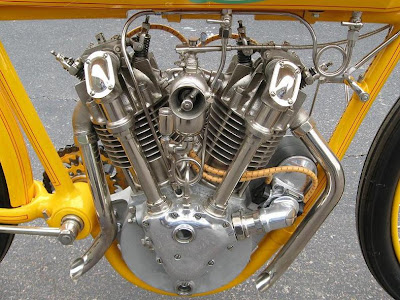
This 1914 Pope is another bike coming up for auction on July 12 in Monterey, and is worth a second look. It's probably even more rare than the Cyclone, and possibly a unique machine.
The Pope Manufacturing Company (Hartford, Connecticut) made bicycles initially, and later moved into motorcycles and cars. Their first forays into motorcycle production (from 1901 onwards) used clip-on engines (the ubiquitous deDion Bouton and variants) on their bicycle frames, and were sold through the
 company's existing network of bicycle showrooms. In 1910 the company developed a wholly new motorcycle line, debuting in 1911 with a single-cylinder engine in a loop frame and leaf-spring front suspension. The engine appeared in both inlet-over-exhaust and overhead-valve configurations, both using a direct belt drive from the engine to rear wheel. On the 'deluxe' models (the Model K ohv), a clutch was added to the end of the crankshaft. These overhead-valve machines were among the first production models to use this new valve layout, and much like the 8-valve Indian which was produced in the same year, the valves are set vertically into a relatively flat combustion chamber. This
company's existing network of bicycle showrooms. In 1910 the company developed a wholly new motorcycle line, debuting in 1911 with a single-cylinder engine in a loop frame and leaf-spring front suspension. The engine appeared in both inlet-over-exhaust and overhead-valve configurations, both using a direct belt drive from the engine to rear wheel. On the 'deluxe' models (the Model K ohv), a clutch was added to the end of the crankshaft. These overhead-valve machines were among the first production models to use this new valve layout, and much like the 8-valve Indian which was produced in the same year, the valves are set vertically into a relatively flat combustion chamber. This layout was also used in the legendary JAP '90 bore' engine, although JAP had produced an ohv v-twin engine as early as 1906. Although the ohv layout had clear advantages in breathing and hence power production, the metallurgy of the early 1900's meant that broken valves were a common problem, with consequently disastrous results to the piston and cylinder head. Thus, many racing (and roadster) engines opted for the reliability of the sidevalve layout. The last bike with a sv engine to win at the Isle of Man TT was a Sunbeam in 1922, with Alec Bennett aboard - overhead valve machines were dominant until 193o, when Rudge was the last ohv machine to win the Senior. After that, the race was sole property of overhead-cam machines.
layout was also used in the legendary JAP '90 bore' engine, although JAP had produced an ohv v-twin engine as early as 1906. Although the ohv layout had clear advantages in breathing and hence power production, the metallurgy of the early 1900's meant that broken valves were a common problem, with consequently disastrous results to the piston and cylinder head. Thus, many racing (and roadster) engines opted for the reliability of the sidevalve layout. The last bike with a sv engine to win at the Isle of Man TT was a Sunbeam in 1922, with Alec Bennett aboard - overhead valve machines were dominant until 193o, when Rudge was the last ohv machine to win the Senior. After that, the race was sole property of overhead-cam machines.In 1912 Pope introduced a very advanced ohv v-twin of 998cc, with plunger rear suspension (which can be seen in two of the period racing pix), although still direct drive. In 1914, a two-speed countershaft gearbox was added to the twin, which became the ultimate configuration of the Pope, as production ceased in 1916, due to financial difficulties.

The machine coming up for auction has apparently no peers, for no other 'Board Track Racer' Pope models seem to have survived. The only photograph I've seen of a comparable machine is this one, with D.O. Kinnie aboard a Board Track Pope, at the Ascot speedway in Los Angeles, at a 100-mile race on Jan.31, 1915. The bottom two period racers are from 'stock class' events, where the machines were expected to be stripped standard roadsters, not purpose-built 'factory' racers.
 All three period photos show variations on handlebars, forks, and frame layout, although the front end of the auction bike looks very similar to the bike in the middle pic, with its unusual soldered-up 3-piece dropped handlebars. Clearly the lower two photos depict converted roadsters with fenders, rear stands, and brakes (!); such excess weight would never have appeared on the pared-down factory racers.
All three period photos show variations on handlebars, forks, and frame layout, although the front end of the auction bike looks very similar to the bike in the middle pic, with its unusual soldered-up 3-piece dropped handlebars. Clearly the lower two photos depict converted roadsters with fenders, rear stands, and brakes (!); such excess weight would never have appeared on the pared-down factory racers.
Stephen Wright in 'The American Motorcycle; 1869-1914' (Megden, 2001), mentions that the Popes did well in 'stock-class' racing. I haven't seen mention of how they did in Board Track racing, although they do figure among the runners.
More Pope information can be found here (Smithsonian exhibit), and here (How Stuff Works website).
I'm indebted to Stephen Wright's books 'The American Motorcycle' and 'American Racer; 1900-1940' for the period photos, and Jerry Hatfield's 'American Motorcycles' for info on the Pope factory. It's time for a reprint of the 'American Racer' books - they're fantastic, and on par with Joe Bayley's 'The Vintage Years at Brooklands' for my all-time favorites.










































































